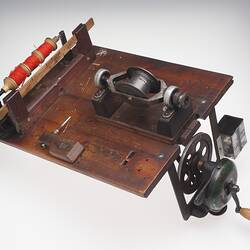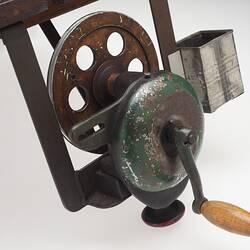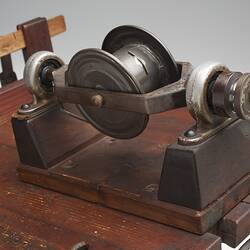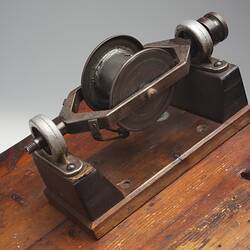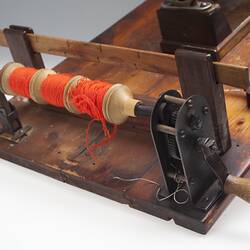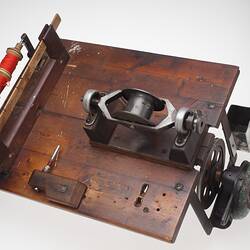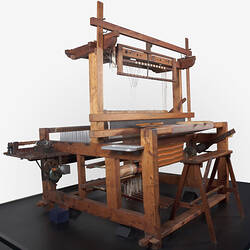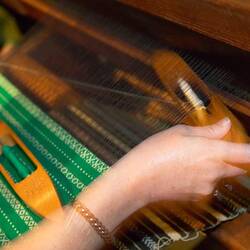Summary
Unplying machine designed and made by Ervins Apinis in the Parkes Holding Centre in Canberra in 1950. Made from cans, scrap metal and wood, this machine was designed to be used with the countermarch loom. Ervins migrated to Australia with his wife Anna, son Eriks and Anna's father Ernest in 1950 after spending time in a Displaced Persons Camp, Memmingen, in Germany following World War Two. Ervins used the unplying machine to unply balls of wool to make weaving threads for Anna, as weaving materials were difficult to find in post-war Australia.
In Latvia, Ervins worked as a qualified road engineer. After arriving in Australia, he was employed as a railway labourer, eventually becoming a rail-bond welder. His wife Anna had studied weaving in Latvia and in Australia became one of the few suppliers of Latvian national costumes in the 1950s and 1960s, and exhibited her weaving nationally, at exhibitions and Latvian cultural festivals. Ervins was actively involved in helping Anna with her craft and designed many weaving devices used by her. She fulfilled her dream to keep her cultural traditions alive through her daughter Anita who continues to weave to this day.
Physical Description
Unplying machine made from wood and metal. It works on the principal of a hand driven fly wheel which has a handle which when turned, causes a cast metal device to rotate which facilitates the unravelling of the wool to separate into individual strands. Components include a wooden plank, wooden bobbins and specifically designed cast metal components. There is a leather thong which acts as a belt on the hand driven wheel. Additional components include four rectangular pieces of timber of similar size and a cast metal angled bar used to attach it to the side of the loom. There is an aluminium can riveted onto a piece of aluminium which is then screwed onto a metal support. This can holds a plastic bottle of 'Singer Oil'.
Significance
Significance: These items form part of the Apinis Latvian weaving collection, a collection of Latvian weavings, tools (including a countermarch floor loom), weaving notebooks, costume items and audio visual interviews. Its historical and cultural significance lies in the comprehensive documentation of the story through artefacts and narratives, the quality of the weavings and the rarity of particular items such as the loom created in a German displaced persons' camp after World War II and notebooks kept from the 1930s to preserve traditional Latvian weaving techniques. The collection documents the maintenance and transportation of cultural traditions.
More Information
-
Collection Names
-
Collecting Areas
-
Acquisition Information
Donation from Mrs Anita Apinis-Herman, Jun 2010
-
Maker
Mr Ervins Apinis, Canberra, Australian Capital Territory, Australia, 1950
-
User
-
Classification
-
Category
-
Discipline
-
Type of item
-
Exhibition Collection Management
700 mm (Length), 450 mm (Width), 430 mm (Height)
-
Keywords
Handcrafts, Inventions, Latvian Communities, Latvian Immigration, Making Do, Settlement, Weaving, Woodworking, Refugees, Displaced Persons, Displaced Persons Camps

